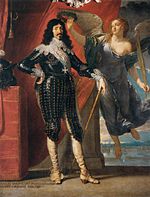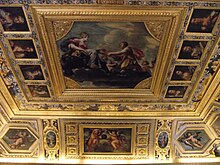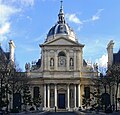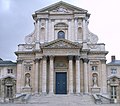Louis-treize

As Louis XIII one occurring in France style is visual arts , the arts and crafts and architecture called that during the reign of Louis XIII. ( French Louis Treize ) was predominant from 1610 to 1643. It corresponds to the early baroque and embodies the transition from late mannerism to the early forms of French classicism , before this culminated in the Louis quatorze style from the 1660s in the time of Louis XIV . However, the first approaches of the Louis-treize style appeared in France as early as the late 1590s.
Reminiscence of the motifs of antiquity common in the Renaissance was primarily the monumental, but in simpler, straight lines. By deviating from regularity, however, baroque harbingers were already heralded. For this reason, the Louis Treize style is characterized by two extremes, the manifestations of which coexisted: the extremely simple and the heavily overloaded.

At the beginning of the reign of Louis XIII. (until around 1620) art and handicrafts were still influenced by the late Mannerist forms of the Second School of Fontainebleau , established by Henri IV in the 1590s , to which Flemish and French artists belonged, such as the painter Martin Fréminet (1567–1619), who from 1608 until his death in 1619 created the ceiling decoration in the Trinity Chapel of Fontainebleau , while Ambroise Dubois (1543–1614 / 15) painted a cycle of paintings in the Salon Ovale (also Salon Louis XIII ) of Fontainebleau around 1610 . In the interior decoration scrollwork and grotesque decorations were still modern (e.g. Salle du Livre d'Or , Palais du Luxembourg , Paris; or the ceiling in the Salon des Gardes , Fontainebleau ).
Also the Queen Mother Maria de 'Medici , who came from Florence , who as regent the French state affairs for her underage son Louis XIII. tried to influence French art and architecture, in particular through the construction of the Palais du Luxembourg (based on the model of the Palazzo Pitti ), which was decorated between 1621 and 1625 by the Flemish Baroque painter Peter Paul Rubens (cycle of 21 paintings today in the Louvre , Paris). Rubens' exuberant style, however, had little influence on French painting, where there was a tendency towards a cooler, more reserved classicism.
painting

French painting in the time of Louis XIII. is probably the genus that has survived the most. In contrast to the previous and following epochs, it offers a relatively colorful overall picture with a juxtaposition of very different currents (similar to Italy). Basically, painters drew heavily on Italian and Flemish models, but the French generally tended to take a more rational, moderate approach. The epoch produced a number of great French painters, some of whom lasted into the subsequent era of Louis XIV.
The two court painters Simon Vouet and Eustache Le Sueur , and above all Nicolas Poussin, shone in the fields of mythological , historical and religious painting and in an Italian-influenced classical style . Vouet spent many years in Rome, where he was initially under the influence of Caravaggio , and was in 1627 by Louis XIII. recalled to Paris and appointed Peintre du Roi (painter to the king); he had a great influence on other artists and created a. a. Paintings for the royal castles of the Louvre (where he also lived), in Saint-Germain-en-Laye , Fontainebleau and for the Queen's Palais du Luxembourg .

Poussin spent most of his life in Rome, but had great success in France - he painted a. a. some paintings for the art-loving Cardinal Richelieu for his country estate in Poitou and was invited by him to Paris to work on decorations in the Louvre as "the king's first painter" around 1640–1642 - and was already during his lifetime, but after his death , a role model for French classical music. The same applies to the classicist landscape painter Claude Lorrain .
In addition, the French Caravaggists Valentin de Boulogne , Nicolas Régnier and Nicolas Tournier worked , all of whom created religious images as well as genre scenes . The Caravaggists also include the rather solitary and brilliant Georges de la Tour , who was actually not a French but a Lorraine native, and who often achieved mystical effects in his art by using a candle as the only source of light. According to an unproven anecdote, he should Louis XIII. have given a picture and have been named Peintre du Roi as a thank you . The Le Nain brothers also resorted to Caravaggio's tenebrism , but mixed it with Dutch influences. They are best known for their very realistic genre scenes from the common people (e.g. peasant family and peasant meal (1642) by Louis Le Nain , Louvre , Paris).
Philippe de Champaigne , who came to Paris with Rubens in 1621 to work for Maria de Medici in the Palais du Luxembourg , also created his own style . Champaigne was appointed court painter by the queen in 1628. He mixed various Dutch and Flemish models with Roman- Bologna classicism and a moderate Tenebrism , and received numerous important commissions in Paris, some of which have unfortunately been lost. His portraits of Louis XIII are particularly famous. and by Cardinal Richelieu (in the Louvre , Paris).
In the sculpture were Jacques Sarazin and Jean Warin leader, however, these two artists did not produce truly outstanding works.
Valentin de Boulogne : The Palmist , 1628, Louvre , Paris
Georges de La Tour : An angel appears to St. Joseph in a dream , Musée des Beaux-Arts de Nantes
Nicolas Poussin : Selene and Endymion , about 1630, Detroit Institute of Arts
Claude Lorrain : Sunrise at the Harbor , around 1634, Hermitage , St. Petersburg
Philippe de Champaigne : Triple portrait of Cardinal Richelieu , ca.1642 (?), National Gallery , London
Simon Vouet : Saturn (= time), defeated by Cupid, Venus and Hope , approx. 1645–46, Musée du Berry, Bourges
Interior decoration and handicrafts

With the Edict of Nantes , the Huguenot Wars in France were initially ended and the country pacified. The king and his court now spent a lot of time in their own residences instead of in army camps . This resulted in a growing demand for comfortable and at the same time luxurious wooden furniture, mostly made of oak and fir. The cabinet-making industry experienced a strong boom, because even everyday furniture such as chairs and tables were now provided with an often lush decor and manufactured in numerous variants. Despite richly carved or turned decorations, the furniture was still very bulky, because stability was still in the foreground, which is why the Louis-treize style is characterized by Renate Dolz as "stiff splendor". Popular motifs in the carving were cherubim heads , ornate festons , cartouches , garlands made of fruits or flowers as well as grotesques and acanthus ornaments . Smooth surfaces were often designed using inlay work made of valuable materials such as marble or ebony , although the ebony veneer is said to have come into fashion through Maria de 'Medici. Distinctive features of Louis-treize style furniture are swellable supports in twisted or baluster-like shapes, especially on legs or cross braces. Two basic forms can be distinguished for seating furniture: the chair with a high back and the armchair-like chair with armrests and a low back. They were often equipped with fabric or leather-covered and upholstered seat and back surfaces.
The time of Louis XIII. and the associated peace phase also brought with it the introduction of new, comfortable pieces of furniture that had not been common before. These include the many drawers equipped cabinet cabinets for storing precious objects and jewels as well as pageantry beds with canopies made of precious materials. Louis XIII often held his official receptions lying in a state bed, and so taburettos , small pieces of furniture set up next to the bed, came into fashion at that time .
Two-part cupboard with reliefs after B. Spranger in the upper part, 1st quarter 17th century, Louvre, Département des Arts décoratifs (Salle 31)
Ebony cabinet (Paris c. 1645) and Louis Treize chairs, Louvre , Département des Arts décoratifs (Salle 32)
Rare Louis Treize decor in the Musenkabinett at Oiron Castle
Salon Ovale (or Salon Louis XIII ) in Fontainebleau Castle with a cycle of paintings by Ambroise Dubois (1610). The furniture is from a later time (!).
architecture
Probably the most productive artistic field during the time of Louis XIII. was the architecture, which was partly strongly influenced by Italy.
Basically, under Ludwig XIII. distinguish between two architectural trends: On the one hand there was a typically French style, which is characterized by the three-colored buildings. Red brick masonry was interrupted by corner blocks and window and door frames made of light house stone , a technique called Brique-et-Pierre in French . However, it was already common under King Henry IV and only lived on in the Louis Treize style. The built in this technology building had generally high, with black slate shingles thatched roof, which thus contributed the third color. Examples of this technology are the houses around the Place des Vosges in Paris , the first expansion stage of the Palace of Versailles and the Balleroy Palace designed by François Mansart .
On the other hand, the Gastons d'Orléans wing, built exclusively from light stone , heralded the stricter classicist style at Blois Castle , which would later prevail under Louis XIV (see: Classicist Baroque ). The most famous architect of the Louis Treize style was Salomon de Brosse , who designed both the Palace of Justice ( Palais de Justice ) in Rennes and the aforementioned Palais du Luxembourg for Maria de 'Medici. The facade of the Saint-Gervais church in Paris designed by him is one of the earliest examples of classicist architecture, as is the church designed by Mansart of the Val-de-Grâce abbey founded by Queen Anne d'Autriche . A stronger Italian influence was also noticeable in Jacques Lemercier's designs . According to his designs was commissioned by Cardinal Richelieu as the 1635 begun and 1642 ended Church of the Sorbonne , and Richelieu monumental Palais-Cardinal in Paris (see Fig. Above right), which later became the Palais Royal was renamed and then in the possession The Orléans family arrived; Unfortunately it is no longer preserved, but burned down during the commune uprising in 1871 . Richelieu's luxurious country estate in Poitou has also disappeared.
The Pavillon de la Reine on the Place des Vosges , Paris
Palais du Luxembourg , Paris
The west facade of the Chapelle de la Sorbonne , Paris
Facade of the Saint-Joseph-des-Carmes church, Paris, by Jacques Lemercier
Facade of the church of Val-de-Grâce
See also
- Clothing fashion at the time of the Thirty Years War
- Classicist baroque
- Louis quatorze
- Fontainebleau School
literature
- Various articles and biographies in: Lexikon der Kunst , 12 volumes, Karl Müller Verlag, Erlangen 1994
- Jean-François Barrielle: Le Style Louis XIII . Flammarion, Paris 1989, ISBN 2-08-010343-1 .
- Émile Bayard: Art de reconnaître les styles. Le style Louis XIII . Garnier frères, Paris 1914.
- Jacques Bertrand: Tableau des Styles du Meuble Francais à travers l'Historie . Éditions de l'Ermite, Ville d'Avray 2005, ISBN 2-9503242-1-5 .
- Harold Donaldson Eberlein, Abbot McClure, Edward Stratton Holloway: The practical book of interior decoration . Volume 1. Lippincott, Philadelphia / London 1919, p. 110 ff ( online ).
- Lawrence Gowing: The Louvre Painting Collection , Dumont Verlag, 2001 (originally 1987/88)
- John Kroger: Pocket CEU: Understanding Louis XIII, XIV, XV, and XVI Furniture . In: Fine Furnishings International (FFI). July / August 2006 ( online ).
- Christophe Renault, Christophe Lazé: Les styles de l'architecture et du mobilier . Jean-Paul Gisserot, Paris 2000, ISBN 2-87747-465-8 , pp. 48-54.
- Jean-Pierre Samoyault: Fontainebleau - Tour guide , Les Éditions d'Arts, Versailles, 1985
- Janine & Pierre Soisson: Versailles and the royal castles of Île-de-France , Parkland Verlag, Stuttgart, 1983
- Louis XIII style . In: Encyclopædia Britannica Online . Encyclopædia Britannica, 2011 ( online ).
Web links
- Louis XIII Style Furniture (English)
- Cedric Henon: XVIIth century French Furniture (English, French)
- French Art - Art Under Henri IV. And Louis XIII. 1589-1643 (English)
- Le Style Louis XIII (French)
Individual evidence
- ↑ a b Cedric Henon: XVIIth century French Furniture , accessed August 4, 2011.
- ↑ a b Renate Dolz: Möbelstilkunde . 11th edition. Heyne, Munich 1976, ISBN 3-453-41012-2 , p. 93.
- ^ "Fontainebleau, Schule von", in: Lexikon der Kunst, Vol. 4 , Karl Müller Verlag, Erlangen 1994, pp. 291–294
- ↑ Jean-Pierre Samoyault: Guide du musée national du château de Fontainebleau , Réunion des Musées Nationaux, Paris, 1991, p 113
- ↑ Jean-Pierre Samoyault: Fontainebleau - Guide to the tour , Les Éditions d'Arts, Versailles, 1985, pp. 26-27 ("The King's Bodyguards Room")
- ↑ Janine & Pierre Soisson: Versailles and the royal castles of Île-de-France , Parkland Verlag, Stuttgart, 1983, p. 10
- ↑ Lawrence Gowing: The painting collection of the Louvre , Dumont Verlag, 2001 (originally 1987/88), pp. 322–333
- ↑ Lawrence Gowing: The painting collection of the Louvre , Dumont Verlag, 2001 (originally 1987/88), p. 358
- ↑ a b c d "Vouet, Simon", in: Lexikon der Kunst, Vol. 12 , Karl Müller Verlag, Erlangen 1994, pp. 197-198
- ^ "Le Sueur, Eustache", in: Lexikon der Kunst, Vol. 7 , Karl Müller Verlag, Erlangen 1994, pp. 264-265
- ↑ Lawrence Gowing: The painting collection of the Louvre , Dumont Verlag, 2001 (originally 1987/88), p. 358
- ↑ Lawrence Gowing: The painting collection of the Louvre , Dumont Verlag, 2001 (originally 1987/88), pp. 322–333
- ^ "Poussin, Nicolas", in: Lexikon der Kunst, Vol. 9 , Karl Müller Verlag, Erlangen 1994, pp. 253-258
- ↑ Richelieu's collections were originally in his city palace (today Palais Royal), later became the property of the crown, and from there they came to the Louvre. Lawrence Gowing: The Louvre Painting Collection , Dumont Verlag, 2001 (originally 1987/88), p. 15
- ^ A b "Poussin, Nicolas", in: Lexikon der Kunst, Vol. 9 , Karl Müller Verlag, Erlangen 1994, pp. 253-258, here: p. 255
- ↑ Lawrence Gowing: The painting collection of the Louvre , Dumont Verlag, 2001 (originally 1987/88), p. 304
- ^ "Poussinists", in: Lexikon der Kunst, Vol. 9 , Karl Müller Verlag, Erlangen 1994, pp. 258-259
- ^ "Poussin, Nicolas", in: Lexikon der Kunst, Vol. 9 , Karl Müller Verlag, Erlangen 1994, pp. 253-258, here: p. 254
- ^ "Lorrain, Claude", in: Lexikon der Kunst, Vol. 7 , Karl Müller Verlag, Erlangen 1994, pp. 320–323
- ↑ a b "Caravaggists", in: Lexikon der Kunst, Vol. 3 , Karl Müller Verlag, Erlangen 1994, p. 103
- ^ "Valentin de Boulogne", in: Lexikon der Kunst, Vol. 12 , Karl Müller Verlag, Erlangen 1994, pp. 84–85
- ↑ a b "Tournier, Nicolas", in: Lexikon der Kunst, Vol. 12 , Karl Müller Verlag, Erlangen 1994, p. 9
- ^ "Régnier, Nicolas", in: Lexikon der Kunst, Vol. 9 , Karl Müller Verlag, Erlangen 1994, p. 375
- ↑ a b c "La Tour, Georges de", in: Lexikon der Kunst, Vol. 7 , Karl Müller Verlag, Erlangen 1994, pp. 202-206
- ↑ Lawrence Gowing: The painting collection of the Louvre , Dumont Verlag, 2001 (originally 1987/88), pp. 410-416
- ↑ a b "Le Nain, Antoine", "Le Nain, Louis" and "Le Nain, Mathieu", in: Lexikon der Kunst, Vol. 7 , Karl Müller Verlag, Erlangen 1994, p. 244
- ↑ Lawrence Gowing: Die Gemäldesammlung des Louvre , Dumont Verlag, 2001 (originally 1987/88), p. 382ff
- ^ "Caravaggists", in: Lexikon der Kunst, Vol. 3 , Karl Müller Verlag, Erlangen 1994, p. 103
- ↑ a b c "Champaigne (also Champagne), Philippe de", in: Lexikon der Kunst, Vol. 3 , Karl Müller Verlag, Erlangen 1994, pp. 159-160
- ↑ see also: Lawrence Gowing: Die Gemäldesammlung des Louvre , Dumont Verlag, 2001 (originally 1987/88), pp. 462–467
- ↑ Lawrence Gowing: The painting collection of the Louvre , Dumont Verlag, 2001 (originally 1987/88), p. 467
- ↑ a b Louis XIII style. In: Encyclopædia Britannica Online. Retrieved August 4, 2011 .
- ↑ a b Louis-treize in the art dictionary by P. W. Hartmann , accessed on August 4, 2011.
- ^ The Renaissance and Louis XIII style. Retrieved August 4, 2011 .
- ↑ furniturestyles.net. Retrieved August 4, 2011 .
- ↑ Today's Palais Royal is a reconstruction from the Third Republic. Janine & Pierre Soisson: Versailles and the royal castles of Île-de-France , Parkland Verlag, Stuttgart, 1983, pp. 14-15


















